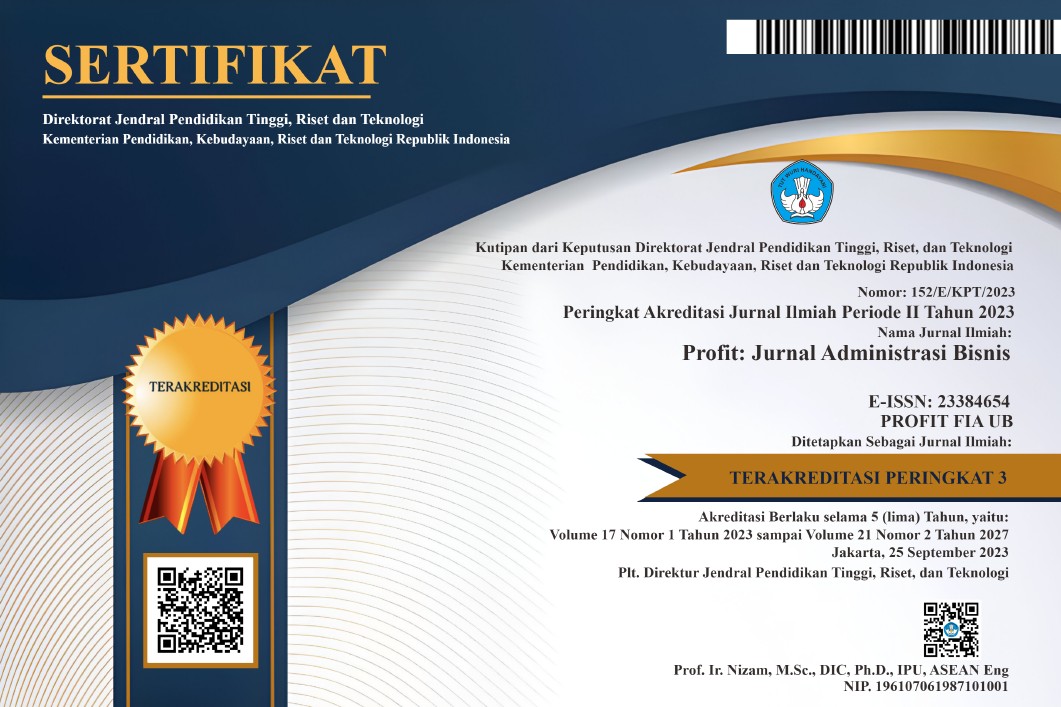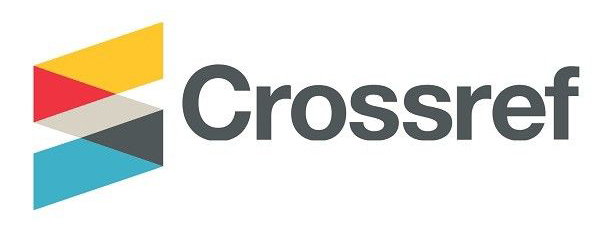PENGARUH CITRA DESTINASI, NILAI PELANGGAN TERHADAP KEPUASAN WISATAWAN DAN NIAT BERPERILAKU WISATAWAN
Keywords:
Destination Image, Perceived Value, Satisfaction, Behavioral IntentionAbstract
The purpose of this study is to present a conceptual model between Destination Image, Customer Value, Tourist Satisfaction and Tourist Behavioral Intention. Based on theoritical and empirical study about destination image, tourist value, tourist satisfaction and tourist behavioral intention, this study explain the constructs and relationships between variables that are used as a basis in constructing conceptual models. Based on previous studies, the authors develop a proposition where a destination with a positive image will be more likely to create tourist satisfaction and positive behavioral intention. In addition, giving value to tourists is also considered as an antecedent of tourist satisfaction and tourist positive behavioral intention. In the end, tourists who are satisfied with the destination will have positive behavioral intentions. Thus, further studies are expected to discuss the variables in this study, as well as develop estimates of other variables that can influence or increase by the variables that have been discussed in this study in the tourism sector, specially in Indonesia.
References
A. Jamal, S., Othman, N., & Nik Muhammad, N. M. (2011). Tourist perceived value in a community-based homestay visit: An investigation into the functional and experiential aspect of value. Journal of Vacation Marketing, 17, 5–15. https://doi.org/10.1177/1356766710391130
Ahmed, Z. U. (1991). The influence of the components of a state’s tourist image on product positioning strategy. Tourism Management, 12(4), 331–340. https://doi.org/10.1016/0261-5177(91)90045-U
Alcaniz, E. B., Garcia, I. S., & Blas, S. S. (2009). The functional-psychological continuum in the cognitive image of a destination : A confirmatory analysis. Tourism Management, 30(1), 715–723. https://doi.org/10.1016/j.tourman.2008.10.020
Alegree, J., & Cladera, M. (2009). Analysing the effect of satisfaction and previous visits on tourist intentions to return. European Journal of Marketing, 43(5), 670–685. https://doi.org/10.1108/03090560910946990
Amalia, I., & Murwatiningsih. (2016). Pengaruh citra destinasi dan nilai pelanggan terhadap loyalitas pengunjung melalui kepuasan pengunjung. Management Analysis Journal, 5(3), 257–268.
Bagozzi, R. (2016). The Self-Regulation of Attitudes , Intentions , and Behavior. (June 1992). https://doi.org/10.2307/2786945
Baloglu, S., & McCleary, K. (1999). A model of destination image formation. Annals of Tourism Research, 26(4), 868–897. Retrieved from https://eurekamag.com/research/003/022/003022121.php
Banki, M. B., Ismail, H. N., Dalil, M., Kawu, A., Bahru, J., & Bahru, J. (2014). Moderating Role of Affective Destination Image on the Relationship between Tourists Satisfaction and Behavioural Intention : Evidence from Obudu Mountain Resort. 4(4), 47–60.
Beerli, A., & Martin, J. D. (2004). FACTORS INFLUENCING. Annals of Tourism Research, 31(3), 657–681. https://doi.org/10.1016/j.annals.2004.01.010
Bhat, A. S., & Darzi, M. A. (2018). Antecedents of tourist loyalty to tourist destinations: a mediated-moderation study. International Journal of Tourism Cities, 4(2), 261–278. https://doi.org/10.1108/IJTC-12-2017-0079
Briner, R. B., & Denyer, D. (2012). Systematic Review and Evidence Synthesis as a Practice and Scholarship Tool. In The Oxford Handbook of Evidence-Based Management (pp. 112–129). https://doi.org/10.1093/oxfordhb/9780199763986.013.0007
Buhalis, D. (2000). Marketing the competitive destination of the future. 21(July 1999).
C. Fakeye, P., & Crompton, J. (1991). Image Differences Between Prospective, First-Time, and Repeat Visitors to the Lower Rio Grande Valley. Journal of Travel Research - J TRAVEL RES, 30, 10–16. https://doi.org/10.1177/004728759103000202
Chen, C.-F., & Tsai, D. (2007). How Destination Image and Evaluative Factors Affect Behavioral Intentions? Tourism Management, 28, 1115–1122. https://doi.org/10.1016/j.tourman.2006.07.007
Chen, C. (2008). Investigating structural relationships between service quality , perceived value , satisfaction , and behavioral intentions for air passengers : Evidence from Taiwan. 42, 709–717. https://doi.org/10.1016/j.tra.2008.01.007
Chen, C., & Chen, F. (2010). Experience quality , perceived value , satisfaction and behavioral intentions for heritage tourists. Tourism Management, 31(1), 29–35. https://doi.org/10.1016/j.tourman.2009.02.008
Chiu, W., Zeng, S., & Cheng, P. S. (2016). The influence of destination image and tourist satisfaction on tourist loyalty : a case study of Chinese tourists in Korea. https://doi.org/10.1108/IJCTHR-07-2015-0080
Choi, T. Y., & Chu, R. (2001). Determinants of hotel guests ’ satisfaction and repeat patronage in the Hong Kong hotel industry. 20, 277–297.
Crompton, J. L. (1979). MOTIVATIONS FOR. Annals of Tourism Research.
Dann, G. M. . (1977). ANOMIE , EGO-ENHANCEMENT AND TOURISM. Annals of Tourism Research, 4(4), 184–194.
Dobni, D., & Zinkhan, G. M. (1990). No Title. Advances in Consumer Research, 17(Levy 1958).
Dominique-Ferreira, S. (2011). Destination image: Origins, Developments and Implications. Revista de Turismo y Patrimonio Cultural, 9, 305–315.
Echtner, C. ., & Ritchie, J. R. B. (1993). The measurement of destination image: an empirical assessment. Journal of Travel Research, 31(4), 3–13. Retrieved from https://eurekamag.com/research/002/523/002523943.php
Elisa, M., González, A., Comesaña, L. R., Antonio, J., & Brea, F. (2007). Assessing tourist behavioral intentions through perceived service quality and customer satisfaction. 60, 153–160. https://doi.org/10.1016/j.jbusres.2006.10.014
Fornell, C., Johnson, M. D., Anderson, E. W., & Bryant, B. E. (1996). The American Customer Satisfaction Index : Nature , Purpose , and Findings The American Customer Satisfaction Index : Nature , Purpose , and. 60, 7–18.
Fornell, C., Mithas, S., & Krishnan, M. S. (2006). Customer Satisfaction and Stock Prices : High Returns , Low Risk. 70(January), 3–14.
Gallarza, M. G., Saura, I. S., & Garcia, H. C. (2002). Towards a Conceptual Framework. 29(1), 56–78.
Gallarza, M., & Saura, I. (2006). Value Dimensions, Perceived Value, Satisfaction and Loyalty: An Investigation of University Students’ Travel Behaviour. Tourism Management, 27, 437–452. https://doi.org/10.1016/j.tourman.2004.12.002
Gartner, C. (1991). The influence of the components of a state ’ s tourist image on product positioning strategy.
Hanif, A., Kusumawati, A., & Mawardi, M. K. (2016). DAMPAKNYA TERHADAP LOYALITAS WISATAWAN ( Studi pada Wisatawan Nusantara yang Berkunjung ke Kota Batu ). Jurnal Administrasi Bisnis, 38(1), 44–52.
Hosany, S. (2006). Destination image and destination personality. (July 2005). https://doi.org/10.1108/17506180710729619
Hutchinson, J., Lai, F., & Wang, Y. (2009). Understanding the relationships of quality, value, equity, satisfaction, and behavioral intentions among golf travelers. Tourism Management, 30(2), 298–308. https://doi.org/https://doi.org/10.1016/j.tourman.2008.07.010
Khan, A. H., Haque, A., & Rahman, M. S. (2013). What Makes Tourists Satisfied ? An Empirical Study on Malaysian Islamic Tourist Destination. 14(12), 1631–1637. https://doi.org/10.5829/idosi.mejsr.2013.14.12.2250
Kim, S., Holland, S., Han, H., Management, S., & Management, H. (2012). A Structural Model for Examining how Destination Image, Perceived Value, and Service Quality Affect Destination Loyalty: a Case Study of Orlando. https://doi.org/10.1002/jtr
Kim, S. S., Mckercher, B., & Lee, H. (2009). TRACKING TOURISM DESTINATION IMAGE PERCEPTION. Annals of Tourism Research, 36(4), 715–718. https://doi.org/10.1016/j.annals.2009.04.007
Kladou, S., & Mavragani, E. (2015). Journal of Destination Marketing & Management Assessing destination image : An online marketing approach and the case of TripAdvisor. Journal of Destination Marketing & Management, (2008), 1–7. https://doi.org/10.1016/j.jdmm.2015.04.003
Kozak, M., Baloglu, S., & Bahar, O. (2010). Measuring Destination Competitiveness: Multiple Destinations Versus Multiple Nationalities. Journal of Hospitality Marketing & Management, 19, 56–71. https://doi.org/10.1080/19368620903327733
Kozak, M., & Rimmington, M. (1999). Measuring tourist destination competitiveness: conceptual considerations and empirical findings1This paper was originally presented at the IAHMS/EuroCHRIE conference, Lausanne, Switzerland in November 1998.1. International Journal of Hospitality Management, 18(3), 273–283. https://doi.org/https://doi.org/10.1016/S0278-4319(99)00034-1
Kumar, V., & Petersen, J. A. (2004). Using a Customer-Level Marketing Strategy to Enhance Firm Performance : A Review of Theoretical and Empirical Evidence. https://doi.org/10.1177/0092070305275857
Lam, S. Y., Shankar, V., Erramilli, M. K., & Murthy, B. (2004). Customer value, satisfaction, loyalty, and switching costs: An illustration from a business-to-business service context. Journal of the Academy of Marketing Science, 32(3), 293. https://doi.org/10.1177/0092070304263330
Lee, C.-K., Lee, Y.-K., & Lee, B. (2005). Korea’s destination image formed by the 2002 World Cup. Annals of Tourism Research, 32, 839–858. https://doi.org/10.1016/j.annals.2004.11.006
Lee, C.-K., Yoon, Y.-S., & Lee, S.-K. (2007). Investigating the relationships among perceived value, satisfaction, and recommendations: The case of the Korean DMZ. Tourism Management, 28, 204–214. https://doi.org/10.1016/j.tourman.2005.12.017
Lee, G., O’Leary, J. T., & Hong, G. S. (2002). Visiting Propensity Predicted by Destination Image. International Journal of Hospitality & Tourism Administration, 3(2), 63–92. https://doi.org/10.1300/J149v03n02_04
Lee, H. K. S., Kim, H., & Lee, S. (2015). Impacts of city personality and image on revisit intention. https://doi.org/10.1108/IJTC-08-2014-0004
Lee, J., Lee, C., & Choi, Y. (2016). Examining the Role of Emotional and Functional Values in Festival Evaluation. 50(6). https://doi.org/10.1177/0047287510385465
Lee, S., Jeon, S., & Kim, D. (2011). The Impact of Tour Quality and Tourist Satisfaction on Tourist Loyalty: The Case of Chinese Tourists in Korea. Tourism Management, 32, 1115–1124. https://doi.org/10.1016/j.tourman.2010.09.016
Liu, Y., & Jang, S. S. (2009). International Journal of Hospitality Management Perceptions of Chinese restaurants in the U . S .: What affects customer satisfaction and behavioral intentions ? 28, 338–348. https://doi.org/10.1016/j.ijhm.2008.10.008
Loureiro, S. M. C., Romero, J., & Bilro, R. G. (2019). Stakeholder engagement in co-creation processes for innovation: A systematic literature review and case stud. Journal of Business Research, 1–22. https://doi.org/10.1016/j.jbusres.2019.09.038
Martin, H. S., & del Bosque, R. (2008). Exploring the cognitive – affective nature of destination image and the role of psychological factors in its formation. Tourism Management, 29, 263–277. https://doi.org/10.1016/j.tourman.2007.03.012
Martin, I. M., & Eroglu, S. (1993). Measuring a Multi-Dimensional Country Image Construct : 210, 191–210.
Masiero, L., & Nicolau, J. L. (2015). Tourism Market Segmentation Based on Price Sensitivity : Finding Similar Price Preferences on Tourism Activities. https://doi.org/10.1177/0047287511426339
Mercille, J. (2005). The Case of Tibet. 32(4), 1039–1055. https://doi.org/10.1016/j.annals.2005.02.001
Moon, K., Ko, Y. J., Connaughton, D. P., & Lee, J. (2013). A mediating role of destination image in the relationship between event quality , perceived value , and behavioral intention. (August), 37–41. https://doi.org/10.1080/14775085.2013.799960
Murphy, P., Pritchard, M., & Smith, J. (2000). The destination product and its impact on traveller perceptions. Tourism Management, 21. https://doi.org/10.1016/S0261-5177(99)00080-1
Nadeau, J., Heslop, L., & Luk, P. (2008). DESTINATION IN A COUNTRY IMAGE CONTEXT. 35(1), 84–106. https://doi.org/10.1016/j.annals.2007.06.012
Nagashima, A. (1970). A Comparison of Japanese and U.S. Attitudes Toward Foreign Products. 25, 68–74.
Oppermann, M. (2000). Tourism Destination Loyalty. Journal of Travel Research, 39(1), 78–84. https://doi.org/10.1177/004728750003900110
Petrick, J. F. (2004). The Roles of Quality , Value , and Satisfaction in Predicting Cruise Passengers ’ Behavioral Intentions. Journal of Travel Research, 42(May), 397–407. https://doi.org/10.1177/0047287504263037
Prayag, G., Hosany, S., & Odeh, K. (2013). The role of tourists’ emotional experiences and satisfaction in understanding behavioral intentions. Journal of Destination Marketing & Management, 2, 118–127. https://doi.org/10.1016/j.jdmm.2013.05.001
Rajesh, R. (2013). Impact of Tourist Perceptions, Destination Image and Tourist Satisfaction on Destination Loyalty: A Conceptual Model. Revista de Turismo y Patrimonio Cultural, 11(3), 67–78.
Ramseook-munhurrun, P., Seebaluck, V. N., & Naidoo, P. (2015). Examining the structural relationships of destination image , perceived value , tourist satisfaction and loyalty : case of Mauritius. Procedia - Social and Behavioral Sciences, 175(230), 252–259. https://doi.org/10.1016/j.sbspro.2015.01.1198
Ravald, A., & Grönroos, C. (1996). The value concept and relationship. European Journal of Marketing, 30, 19–30. https://doi.org/10.1108/03090569610106626
RodrÃguez Molina, M. Ã., FrÃas-Jamilena, D.-M., & Castañeda-GarcÃa, J. A. (2013). The moderating role of past experience in the formation of a tourist destination’s image and in tourists’ behavioural intentions. Current Issues in Tourism, 16(2), 107–127. https://doi.org/10.1080/13683500.2012.665045
Russell, J. A. (1980). A Circumplex Model of Affect. 39(6), 1161–1178.
Sánchez-GarcÃa, J., Callarisa Fiol, L., RodrÃguez-Artola, R., & Moliner, M. (2006). Perceived value of the purchase of a tourism product. Tourism Management, 27, 394–409. https://doi.org/10.1016/j.tourman.2004.11.007
Song, H., & Chen, J. L. (2012). THE HONG KONG TOURIST. Annals of Tourism Research, 39(1), 459–479. https://doi.org/10.1016/j.annals.2011.06.001
Susyarini, N., Hadiwidjojo, D., Supartha, W., & Rohman, F. (2014). Tourists Behavioral Intentions Antecedent Meeting Incentive Convention & Exhibiton ( MICE ) in Bali. 6(25).
Tasci, A. D. A., & Gartner, W. C. (2007). CONCEPTUALIZATION AND OPERATIONALIZATION OF DESTINATION IMAGE. 31(2), 194–223. https://doi.org/10.1177/1096348006297290
Uysal, M., & Jurowski, C. (1994). Testing the push and pull factors. Annals of Tourism Research, 21, 844–846. https://doi.org/10.1016/0160-7383(94)90091-4
van der Haar, J. W., Kemp, R., & Omta, O. (1999). Creating value that can’t be copied : the use of conjoint analysie to assess customer value in new service creation. University of Groningen, Research Institute SOM (Systems, Organisations and Management), Research Report.
Walmsley, D. J., & Young, M. (1998). Evaluative Images and Tourism: The Use of Personal Constructs to Describe the Structure of Destination Images. Journal of Travel Research, 36(3), 65–69. https://doi.org/10.1177/004728759803600307
Wang, X., Zhang, J., Gu, C., & Zhen, F. (2009). Examining Antecedents and Consequences of Tourist Satisfaction: A Structural Modeling Approach. Tsinghua Science & Technology, 14, 397–406. https://doi.org/10.1016/S1007-0214(09)70057-4
Williams, A., & Soutar, G. (2009). Value, satisfaction and behavioral intentions in an adventure tourism context. Annals of Tourism Research, 36, 413–438. https://doi.org/10.1016/j.annals.2009.02.002
Woodruff, R. B. (1997). Customer value : The next source for competitive advantage.
Yoon, Y., & Uysal, M. (2005). An examination of the effects of motivation and satisfaction on destination loyalty : a structural model. 26, 45–56. https://doi.org/10.1016/j.tourman.2003.08.016
Yuksel, A. (2001). Managing customer satisfaction and retention: A case of tourist destinations, Turkey. Journal of Vacation Marketing, 7, 153–168. https://doi.org/10.1177/135676670100700205
Zhang, H., Fu, X., Cai, L., & Lu, L. (2014). Destination image and tourist loyalty: A meta-analysis. Tourism Management, 40, 213–223. https://doi.org/10.1016/j.tourman.2013.06.006
Downloads
Published
Issue
Section
License
The copyright of the received article shall be assigned to the journal as the publisher of the journal. The intended copyright includes the right to publish the article in various forms (including reprints). The journal maintains the publishing rights to the published articles.

This work is licensed under a
Creative Commons Attribution-NonCommercial 4.0 International License
















